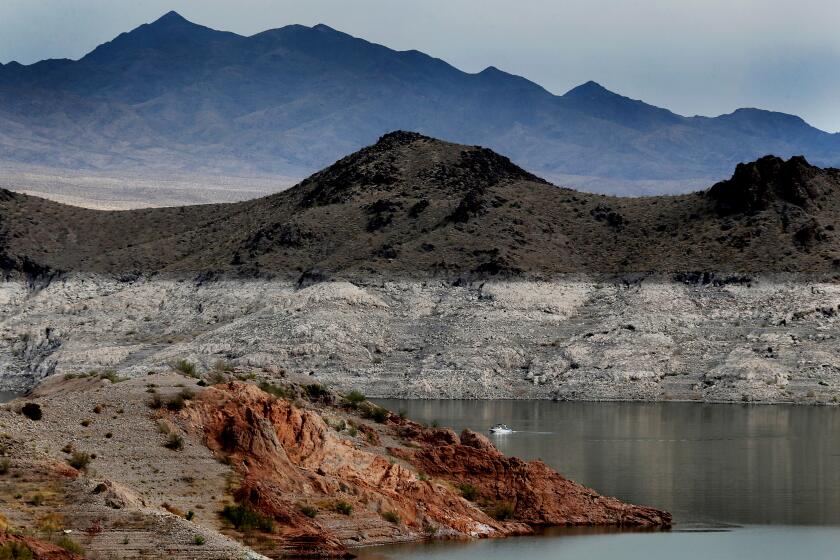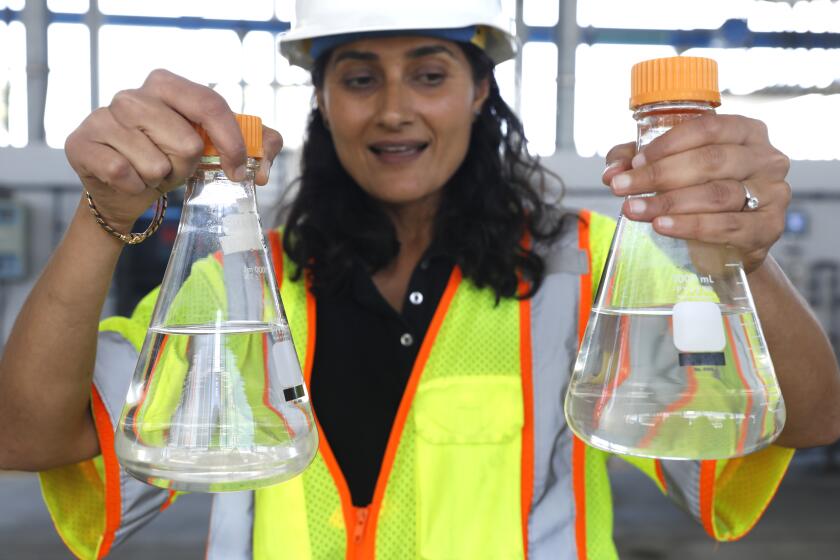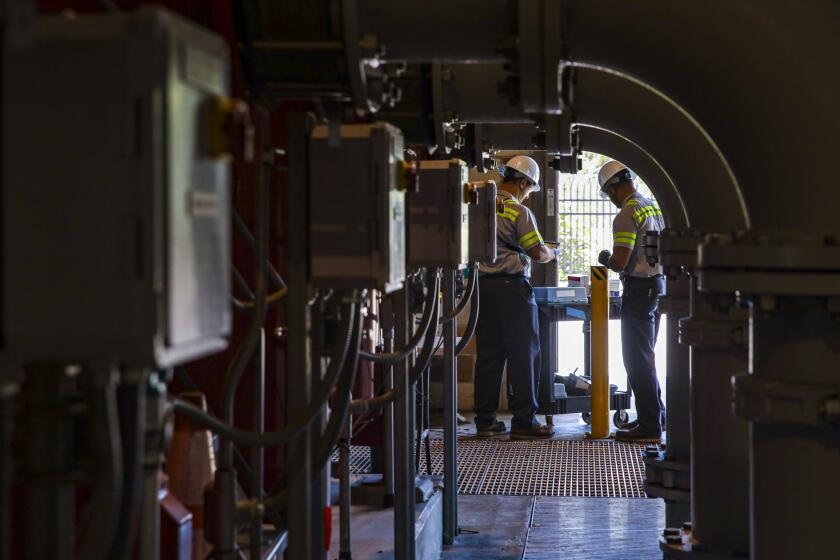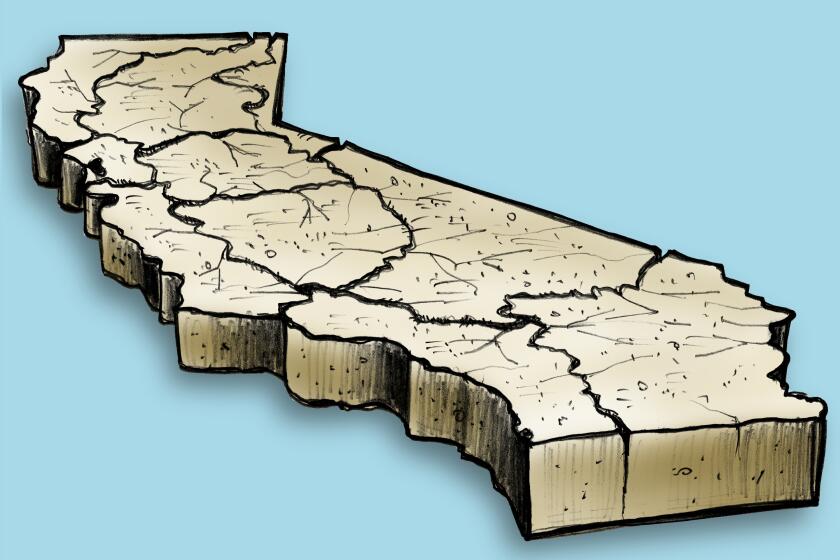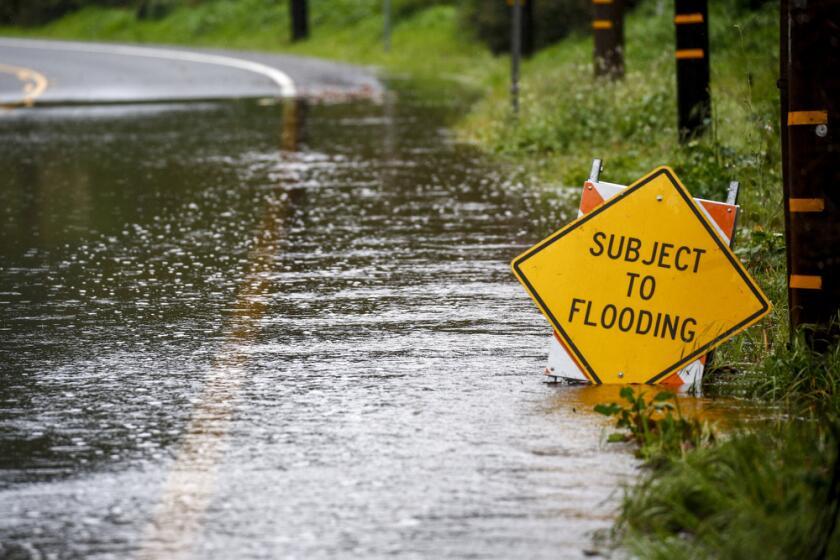L.A. is conserving water at record levels, but it’s not enough as drought worsens

During a summer of soaring heat, shrinking supplies and mandatory drought restrictions, Los Angeles residents conserved water at an impressive pace in August, with that month’s usage dropping below a record low set during the previous drought.
But it’s becoming clear that this alone is not going to be enough. The crisis on the Colorado River, a key source of water for Southern California, is expected to bring painful cuts to supplies in the coming months. And hopes of a wet winter are looking more unlikely with another year of dry La Niña in the forecast.
Now, the pressure is on to not only increase savings, but also double-down on efforts to reduce reliance on imported supplies and to invest in long-term water solutions.
“We have to stop thinking of this as responding to this drought and acknowledge that these droughts are becoming more frequent and severe,” said Heather Cooley, director of research at the Pacific Institute. “Action that we take now — and continue to take even after this drought ends — will be important for the future.”
Recurring drought and rising temperatures have already begun to alter the landscape of California and the American Southwest, researchers warn.
The city’s nearly 4 million residents used about 10% less water in August than the same month the prior year, despite this past August being hotter by an average of 3 to 5 degrees, the Los Angeles Department of Water and Power reported this week. It was the third consecutive month of such records, following a 9% reduction in June and 11% reduction in July.
The figures show a strong response to the new rules, which include two-day-a-week outdoor watering restrictions for residents served by the DWP. Although conservation continues to play an important and immediate role in the region’s response, Cooley and others said that improved water recycling and infrastructure — as well as enhanced responses from business, industry and government — will be needed to reduce reliance on water from Northern California and the Colorado River.
“Those numbers are an improvement, but they indicate that more can be done,” Cooley said. “We’re not done yet, and I think that’s good news, because we are facing a hotter, drier future due to climate change.”
There are many signs of progress statewide. DWP data from the previous severe drought show a significant reduction in supply volumes during August — typically one of the hottest months of the year, with the highest water usage. The agency supplied customers with 43,108 acre-feet in August of this year, compared with 46,427 acre-feet in August 2015, when cities and towns were under mandatory orders to cut water use by 25%. An acre-foot of water equals about 326,000 gallons, more than enough to supply two to three households for a year.
Mayor Eric Garcetti praised Angelenos for cutting back this summer.
“When we acknowledged that there was an urgent need to reduce water use, for the third straight month Angelenos did more than just heed our call — they embraced it,” he said. “Increasingly, I think Angelenos are making conservation a way of life, not just something you have to pick up because it’s a crisis moment, but kind of an acknowledgement of the new abnormal.”
Garcetti said applications for turf-replacement programs have soared under the new watering rules, including a roughly fivefold increase between June and September compared with the same period last year. He said those investments will pay dividends in the long run and may not even be reflected in the latest conservation data, as many projects are underway.
In the face of dire drought, cities and water agencies are now investing heavily in large-scale wastewater recycling facilities.
But he also acknowledged the worsening crisis requires an “all of the above” response.
“We have to of course conserve first — you can do that in the short and near term,” he said. “But it’s continuing to double-down on our capture and clean. And in the longer term, the toughest one and the most expensive, but the ultimate insurance, is going to be recycling.”
Recycled water makes up 2% of the city’s drinking water. Officials are working to increase that number to as much as 35% by converting the city’s oldest wastewater treatment plant into an advanced water purification facility, among other projects. The goal is to recycle all available treated wastewater from the Hyperion Water Reclamation Plant into potable water by 2035, effectively creating another independent water supply for Los Angeles that will reduce the city’s reliance on imported water.
“I certainly hope my successor will ensure we bring that number to 35%,” said Garcetti, referencing the upcoming mayoral election in Los Angeles. “Anybody running for mayor would be silly not to ensure that this actually happens.”
Also underway is a remediation project in and around the San Fernando Groundwater Basin, an important source of groundwater for Los Angeles, Burbank and Glendale that for years sat unused due to pollution.
“We have a lot of water, even on these very dry years, that we’re wasting that we could remediate and capture in the San Fernando Valley,” he said. “So as long as we keep cleaning that aquifer, I think that’s going to be a great place for storage long term as well.”
Los Angeles is considering ‘direct potable reuse,’ which means putting purified recycled water directly back into drinking water systems.
Angelenos aren’t alone in their efforts. Collectively, the 26 agencies that receive supplies from the Metropolitan Water District of Southern California, the region’s massive water wholesaler, have continued to keep usage at or below allocations since the MWD ordered cuts earlier this year, according to data provided by the agency.
MWD executive officer and assistant general manager Deven Upadhyay said the response was “really, really good news,” but also acknowledged that the current drought conditions are historic.
“The conservation we’re seeing right now and the performance we’re seeing — would that allow us to survive through another year of drought? I think absolutely, it likely would allow us,” he said. “But that’s not our goal. Our goal is not to have people forced into taking these emergency actions. We want people to continue to be efficient, but to get to a point where there’s some more normal conditions.”
Like Garcetti, Upadhyay said water recycling projects will be the key to achieving that goal, including an initiative known as Pure Water Southern California, which will eventually produce up to 150 million gallons daily and significantly supplement supplies. When completed, he said, it will be the largest water purification program in the nation.
Also significant are smaller initiatives including bans on watering “nonfunctional” grass — such as grass found in decorative medians — as well as major investments in water conveyance, which will help the MWD move supplies more freely within its distribution system, he said.
While state reservoirs may see some some storage boosts next year due to a combination of management decisions and rainfall, Upadhyay said, “the same cannot be said for the Colorado River,” which is a much larger, slower-moving system that is continuing to decline.
The MWD is one of many California water districts experiencing increased pressure to slash usage of Colorado River water. The board is discussing expanding the reductions it already has in place for State Water Project-dependent areas to its entire service area in order to get there, he said. No official plans have been announced.
The latest maps and charts on the California drought, including water usage, conservation and reservoir levels.
Now, all eyes are on the fall as the forecast calls for a rare third consecutive year of La Niña, a tropical climate pattern associated with dry conditions in the Southwest. There is a strong possibility that the pattern will linger through the winter, forecasters said.
However, officials noted that the water year, which runs from Oct. 1 to Sept. 30, is not over. It’s still uncertain whether any significant atmospheric rivers or storms will manifest this winter, as they did last year despite La Niña.
“There is much to be seen still as the water year develops and supply conditions develop,” said Sabrina Tsui, manager of resource development and watershed management at the DWP. “The efforts by the residents of Los Angeles are really remarkable to date. We will have to see how the conditions develop in the coming months, and see what else is necessary and what supplies the Metropolitan Water District may have available to its member agencies for next year.”
While urban areas such as Los Angeles demand a significant amount of California’s water, they are far from the thirstiest sector in the state. That title goes to agriculture, which accounts for about 80% of water that is diverted and pumped for human use. Though many farms and irrigation districts have seen their supplies tightened and fields fallowed, officials said more savings could be eked out.
Researchers say California’s cities have big potential to use water more efficiently while taking advantage of stormwater and recycled wastewater.
Cooley, of the Pacific Institute, noted that other sectors, including businesses, government and institutions such as hospitals, schools and prisons, can also step up their efforts by improving their processes and changing out their landscapes, among other actions. Even water utilities could do more by scanning for and reducing leaks.
Individual conservation efforts do add up, she said, including transitioning to drought-tolerant landscaping and installing higher-efficiency appliances. A recent study from the Pacific Institute found that a host of existing technologies and standard practices could help reduce total urban use in the state by as much as 48%.
Cooley also said that efficiency does not have to mean deprivation.
“With efficiency, we can do the things we want to do with less water,” she said. “We’re still able to wash our clothes. We’re still able to take showers, to flush our toilets and even have beautiful, vibrant landscapes. We’re just making different choices.”
More to Read
Sign up for Essential California
The most important California stories and recommendations in your inbox every morning.
You may occasionally receive promotional content from the Los Angeles Times.
